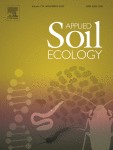Ver ítem
- xmlui.general.dspace_homeCentros Regionales y EEAsCentro Regional Salta - JujuyEEA SaltaArtículos científicosxmlui.ArtifactBrowser.ItemViewer.trail
- Inicio
- Centros Regionales y EEAs
- Centro Regional Salta - Jujuy
- EEA Salta
- Artículos científicos
- Ver ítem
Effect of two broad-spectrum fungicides on the microbial communities of a soil subjected to different degrees of water erosion
Resumen
The impact of both fungicide and water erosion on soil microbial communities has been little studied, and far less in subhumid-dry climates. To help fill this knowledge gap, we evaluated the influence of two broad-spectrum fungicides applied to soil subjected to different degrees of water erosion on microbial population and function. Soil samples were taken from an experimental site under three water erosion levels: an agricultural land subjected to
[ver mas...]
The impact of both fungicide and water erosion on soil microbial communities has been little studied, and far less in subhumid-dry climates. To help fill this knowledge gap, we evaluated the influence of two broad-spectrum fungicides applied to soil subjected to different degrees of water erosion on microbial population and function. Soil samples were taken from an experimental site under three water erosion levels: an agricultural land subjected to minimum water erosion by terrace farming (MIN), an agricultural land subjected to moderate water erosion without terrace farming (MOD), and a land with no water erosion control treatment (non-eroded, NON). Three dosages of both carbendazim and iprodione were applied to microcosms, and the responses of microbial community and function were examined after 30-day exposure. Phospholipid fatty acid (PLFA) analysis, soil enzyme activities, and microbial abundances estimated by quantitative real-time PCR (qPCR) were used to evaluate the impact of carbendazim and iprodione fungicides applied at three dosages on microbial community structure and enzyme activities. The lowest values of fluorescein diacetate hydrolase (FDA), dehydrogenase, urease, and glucosidase activities were registered in soil under moderate erosion, while the highest ones were observed in non-eroded soils. Both carbendazim and iprodione decreased C- and P-related activities, even when those fungicides were applied at field rate doses. Thus, phosphomonoesterase, glucosidase, and xylosidase in soil treated with fungicides applied at recommended field rate decreased by 46 %, 61 %, and 34 % compared to soil without fungicide application. The lowest values of PLFA biomarkers for Gram-positive bacteria, Gram-negative bacteria, and arbuscular mycorrhizal fungi were registered in soils treated with the highest dose of both carbendazim and iprodione. Thus, Gram-positive bacteria, Gram-negative bacteria, arbuscular mycorrhizal fungi, and fungal PLFA biomarkers in soils without fungicide application were about 36 %, 3 %, 47 %, and 82 % higher than those soils treated with the highest doses of fungicides, respectively. In addition, the highest doses of fungicide application tended to greater decrease total PLFAs in both non-eroded and minimum eroded compared to moderate eroded soils. Similarly, the response of bacterial and fungal populations to fungicide treatment was more pronounced in non-eroded soils than in eroded soils. This study illustrates how the interactions between fungicides and water erosion levels affect soil enzyme activities, microbial abundances, and microbial community structure in agroecosystems.
[Cerrar]

Autor
Verdenelli, Romina A.;
Dominchin, María F.;
Barbero, Florencia Magali;
Perez Brandan, Carolina;
Aoki, Antonio;
Vargas Gil, Silvina;
Meriles, José Manuel;
Fuente
Applied Soil Ecology 190 : 104984 (October 2023)
Fecha
2023-10
Editorial
Elsevier
ISSN
0929-1393
1873-0272 (online)
1873-0272 (online)
Formato
pdf
Tipo de documento
artículo
Palabras Claves
Derechos de acceso
Restringido
 Excepto donde se diga explicitamente, este item se publica bajo la siguiente descripción: Creative Commons Attribution-NonCommercial-ShareAlike 2.5 Unported (CC BY-NC-SA 2.5)
Excepto donde se diga explicitamente, este item se publica bajo la siguiente descripción: Creative Commons Attribution-NonCommercial-ShareAlike 2.5 Unported (CC BY-NC-SA 2.5)


